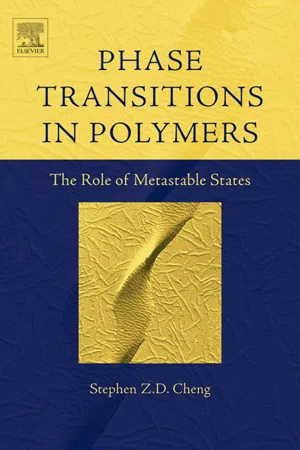![]()
Chapter 1. Introduction
- Phases in Single-Component Systems 1
- Macroscopic description of phases 1
- Microscopic description of phases 3
- Connection between microscopic descriptions and macroscopic properties 7
- Phase Transitions in Single-Component Systems 10
- Definitions of phase transitions 10
- Phase equilibrium and stability 12
- References and Further Reading 14
1. Phases in Single-Component Systems
This chapter provides a brief review of our basic understanding of phases from both macroscopic and microscopic points of view. From the macroscopic perspective, phases can be identified utilizing a series of thermodynamic properties based on classical thermodynamics; from the microscopic perspective, a phase needs to be defined on the basis of its structural symmetry and the types of order found in the phase. These two different perspectives can be reconciled by using statistical mechanics to bridge the length scale differences. When one phase changes to another isobarically or isothermally, this change is a phase transition. Phase transitions are not only scientifically interesting, but also practically important. In this chapter, the Ehrenfest definition of phase transitions in single-component systems is introduced. These transitions can be categorized as discontinuous transitions or critical phenomena. The equilibrium phase and stability can be determined on the basis of classical thermodynamics. By knowing these pieces of information, one can construct a phase transition free energy landscape for a system.
1.1. Macroscopic description of phases
The states of matter and the transformations between them are subjects of extensive research in condensed matter physics and solid state chemistry. They also provide a fundamental basis for today's materials science and engineering fields, as well as play an important role in profoundly improving the world's economy and our quality of life. It is well known that solids, liquids, and gases are the three basic states of matter. Phenomenological definitions of these states are introduced in elementary school, where it is taught that a substance which can fill a container and conform to its shape is a liquid. More specifically, liquids are a class of substances that possess a fixed volume but not a fixed shape. On the other hand, a substance that possesses both a fixed volume and a fixed shape is a solid, while a gas has neither a fixed volume nor a fixed shape. A more complete understanding of these states, based on both macroscopic and microscopic descriptions, comes much later in our education.
Quantitative macroscopic descriptions of the states of matter were first presented approximately two hundred years ago. A series of macroscopic thermodynamic properties, such as temperature, pressure, enthalpy, entropy, and free energy, were used to describe an equilibrium phase, which defines a state of matter. The basis for this kind of description is derived from a few empirical laws of classical thermodynamics which were established in the nineteenth century during the Industrial Revolution. Among them, the most important laws are that heat does not spontaneously move from a low temperature body to a high temperature body and that at equilibrium, the temperatures of the two bodies must be equal. The conservation of energy dictates that although energy can be transformed from one type to another, it cannot be created or destroyed. This principle constitutes the first law of thermodynamics. Next, work can be completely transferred to heat, but heat cannot be transferred to work with 100% efficiency. The energy which cannot be transferred to work is related to entropy. The second law of thermodynamics states more precisely that the heat lost is the product of absolute temperature and entropy. The third law of thermodynamics quantitatively describes the relationship between entropy, a macroscopic property, and statistical thermodynamic probability (the Boltzmann equation).
Thermodynamic descriptions of a phase are based on changes in the thermodynamic properties (or functions) of different systems, such as isolated systems (without energy and mass transfer to the surroundings), closed systems (without mass transfer, but with energy transfer to the surroundings), or open systems (with both energy and mass transfer to the surroundings). The thermodynamic properties, enthalpy (H), entropy (S), and Gibbs free energy (G), of a closed, isobaric, single-component, single-phase system can be calculated with calorimetric isobaric heat capacity data (CP) at different temperatures. The corresponding equations are given below:(1.1)
The thermodynamic properties of a closed, single-component, single-phase system at constant volume are internal energy (U), entropy (S), and Helmholtz free energy (F). Each can be calculated from isometric heat capacity data (CV) at different temperatures. The corresponding equations are given below:(1.4)
The relationship between isobaric heat capacity and isometric heat capacity follows the equation given below:(1.7)
In this equation, α is the coefficient of thermal expansion, which is defined as (∂V/∂T)P/V, and β is the compressibility, which is defined as −(∂V/∂P)T/V. It is evident how important it is to experimentally and/or theoretically know the heat capacity (CP or CV) of a system, since all of the thermodynamic properties of a phase can be obtained from Eqs. (1.1) to (1.6) (see, e.g., Wunderlich, 2005).
1.2. Microscopic description of phases
The macroscopic thermodynamic properties of a phase originate from the microscopic molecular interactions and motion in the equilibrium state. Generally speaking, molecular interactions promote structural order, while the random nature of thermal motion promotes disorder. In different types of phases, the microscopic structures and motions are different.
To categorize, quantitatively, the microscopic structural order of different phases, a series of mathematical operations is needed. For this purpose, a set of symmetry operations was introduced to represent a set of arbitrary translational, rotational, and reflection operations (the Euclidean group) to define the microscopic structure of a phase. Since liquid- and gas-phase structures are statistically invariant under all of these operations, their symmetry group is the entire Euclidean group that embodies the largest possible number of symmetry operations, and so, fluids have the highest possible symmetry. This cha...







